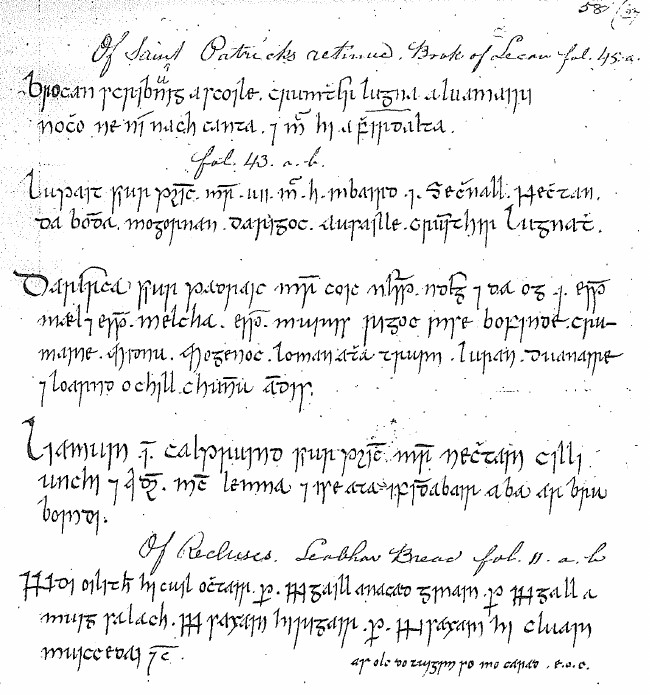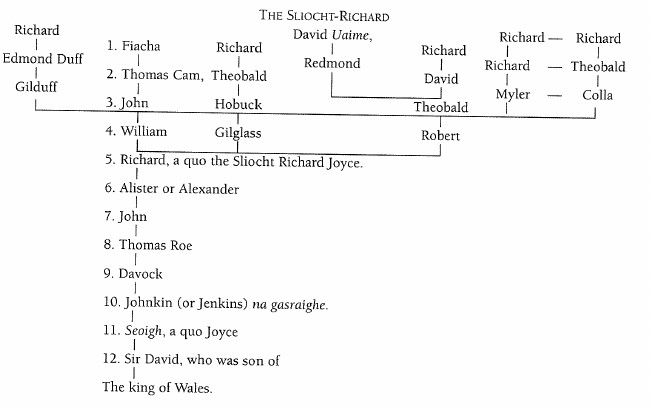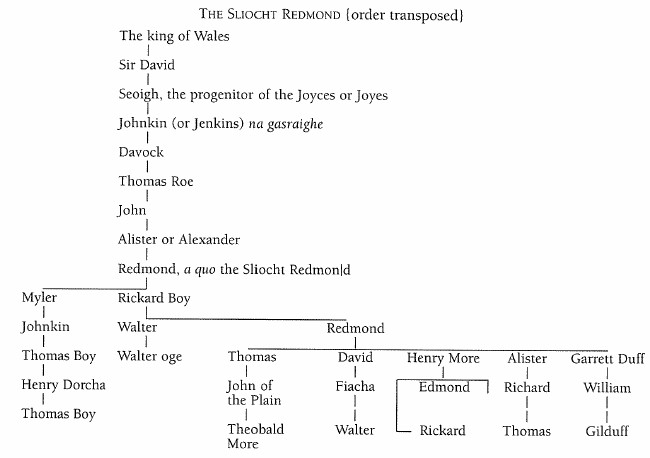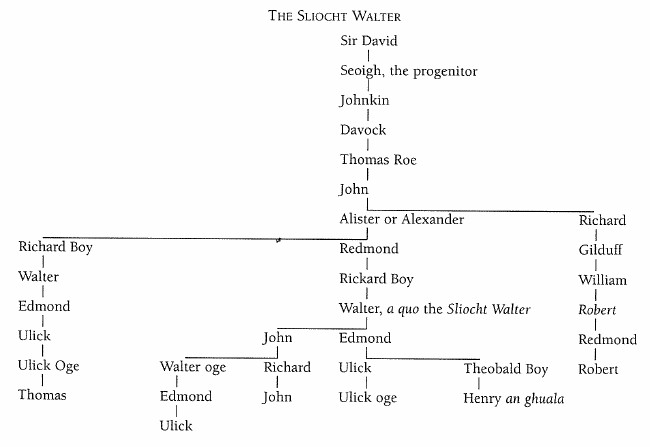Go to Page
June 27th 1839. (Recd. July 19).
Dear Sir,
In treating of Connamara my best plan will be to copy O'Flaherty's words and explain in notes the changes which have taken place in the nomenclatura since his time, and to add (some notices of) such ancient features as he has left unnoticed. By doing this I shall explain many obscure passages in O'Flaherty's (account) which are almost unintelligible to any but an Irish scholar and topographer.
OF JOYCE'S COUNTRY COMPRISING THE ENTIRE OF THE PARISH OF ROSS, AND THOSE PORTIONS OF THE PARISHES OF CONG, BALLAGHALLA AND BALLOVEY LYING WEST OF THE LAKES
Of this territory O'Flaherty wrote as follows in 1684,
The half barony of Rosse, commonly called Joyce Country from a Welsh family of Yoes, Joas, or Shoyes(a) which (who?) held that land from the O'Flaherties formerly part of Partry-an-tslevy,(b) which extended from St. Patrick's hill(c) (i.e. Reek) in the
[NOTES BY JOHN O'DONOVAN]
(a) See Pedigree of the Joyces given in p.[ages 61 to 65.]
(b) In Irish Partraighe an t-Sléibhe, and in Latin Partrigia de monté. See my letter from Ballinrobe on the extent and history of this territory.
(c) By Saint Patrick's hill in the Owles he means Croagh-Patrick in Umallia, now generally called St. Patrick's Reek.
Owles to Lough Orbsen, hath the Barony of Ballynahinshy, Koel-shally Roe,(d) and the Owles(e) on the west of it; and by a high ridge of mountains called Formna mor(f) is divided on the north from the same Owles. From that mountain ({Formna-mor}) Brúin(g) river falling into Lough Measg separates Partry mountain in the barony of Kera(h) from Killbridy (i.e. Kilbride) townland {on} the north side of Lough Measg in the half Barony of Rosse, and yet belonging to the parish of Ballynchalla.(i) On the south side of Kilbridy there is a chappell and well dedicated to St. Bridged.(j) There is on the south side of it an arm of Lough Measg, which shoots into the country westward about four miles to Glentresky.(k) On the west of Killbridy townland is Lough-na-fohy,(l) out of which the river of Gairge comes into that (arm) of Lough Measg.
[NOTES BY JOHN O'DONOVAN]
(d) Called by the Four Masters Caol-Sháile Ruadh. It is now called in Irish Caol-Sháire (r for l Ruadh and Anglicised Killary.
(e) Called In Irish Umhall and in Latin Umallia. It was O'Mailly's country and includes the Baronies of Murresk and Burrisool.
(f) So called at this day, but pronounced Forrumna More.
(g) Now called (in Irish) Abhainn Bhruin, and anglicised Owenbrin and Owenwrin. It passes through the townland of Cappanacreha.
(h) Kera, now Carra, a barony in the County of Mayo, called in Irish Ceara. See my letter from Ballinrobe on the extent and history of the territory of Ceara.
(i) Called in Irish Baile an chala, i.e. the townland of the Callow, called anciently Cala Locha Measga i.e. the Callow of Lough Mask. See my letter from Ballinrobe on this parish.
(j) This chapel is now in ruins in the townland of Kilbride and near it the Well of St. Brigit called in Irish Cró-Brighde, and another well called Tobar Muire after the Virgin Mary.
(k) This name is not in the name Books. Glantrague.
Within that arm of Lough Mask is the Earl's island,(m) where Edmond Burke, 2nd son of Richard, the Red Earl of Ulster, Anno Domini 1338, was put to death; which should therefore rather be called "the Earl's son's Island"; but the male line of that {family} being all to (i.e. with the exception of) him extinct, most likely he was reputed and commonly called Earl of Ulster, there being but one girl about seven years old, his nephew William Earl of Ulster's daughter, after (i.e. postea) Duchess of Clarence apparent heir general, during whose nonage Edmond was joined in Commission with Malachias, archbishop of Tuam for the government of Connaught until
[NOTES BY JOHN O'DONOVAN]
(l) [Referred to on MS p. 33] Now (called) Lough-na-feoy (and lies) in the parish of Ross, but the river which it sends into the arm of Lough Mask is now called Finny, not Gairge. This name however (which) it has received from a townland is not properly speaking that of the river, though it is a far nicer one than Gairge.
(m) Now called Oileán-an-Iarla, i.e. the island of the Earl. It lies in that arm of Lough Mask which runs up to Toorluggagh in the Parish of Ross. I think we should call it the Earl's island on the Ordnance map, lest the Irish form Illaunanearla might not be understood. Many Irish names look very indistinct when Anglicised, and this is one of the many.
he was seized upon by Sir William Bourke aforementioned, his sons on Low Sunday the 19th of April in the friar house of Ballinrobe, Roger de Flet, Seneschal of Connaught and Nicholas Lienot with other nobles of the company being killed on (in?) the place. He was that night carried to Lough Measg castle,(n) and the next night to Ballyndeónagh(o) castle; and the third night to that island of Lough Masg, whither the archbishop of Tuam came to bring him and his kinsman to reconciliation; and, as they were on points of agreement, the villains who had the custody of his body, a certain family of the Stantons, dispairing their own safety if he were set at liberty, miserably turned him into a bag (i.e. sack), and cast him out of the island into the lake, with stones tied to the bag, for which they were called Clan-Ulkin(p) ever since. Hence followed great combustion and wars in Connaught
[NOTES BY JOHN O'DONOVAN]
(n) This castle is called by the Four Masters Baile Locha Measga. It is now called Lough Mask Castle. It was re-edified by Sir Thomas Burke after the battle of Kinsale fought in January 1602. See my letter from Ballinrobe on that part of the parish of Ballinchalla lying east of Lough Mask.
(o) In an Inquisition taken in the reign of James I, mention is made of "Castrum et Villa de Bally-Inneónagh in Baroniâ de Rosse". This Castle still retaining its ancient name stands in ruins in the townland of Cappaghnagapple alias Petersburgh near the demesne of Ross.
(p) That is the children of evil.
after. Of this Edmond and his wife Slany daughter of Tordelbach O'Brien, Lord of Thomond, lineally descended the Lords of Castle Connell and Britas, with the rest of the County of Limerick Burkes.
From that arm of Lough Measg towards Cong and Lough Orbsen for 3 miles in length and 3 half miles breadth, there is good arable land, in which line, on the west side of Lough Measg is Ballyndeonagh Castle and Rosse, whence the Barony is named, and where the parish church of Ross(q) parish stands whereof St. Brendan is Patron whose feast is the sixteenth day of May. Ross parish reaches from
[NOTES BY JOHN O'DONOVAN]
(q) I (have) examined this church of Ross with great attention and (have) come to the conclusion that it is all modern except the west gable, and a (small) part of the north and south walls. The west gable contains a doorway in the semi-Cyclopean style, which is certainly as old as St. Brendan himself. It is at present 5f. 0in high, but the ground is perhaps one foot raised. It is 2f. 0in. wide at the top and 2f. 8in. at the bottom, and the wall is 3f. 2in. in thickness. I never met a doorway in any old church which slopes so much, it being 8 inches wider at the bottom than at the top. The left (right) hand side of this doorway as you enter is constructed with seven stones and the left with five. The gable is about 21 feet in breadth, and contains a small Belfry on its top wch. is decidedly modern, and a square window which is modern also. The remaining part of this church is not worth attention.
the west side of Lough Measg, and by the foresaid arm thereof to the western border of the half barony, but between it and Lough Orbsen part of the parish of Cong runs (i. extends) from the river of Cong on the east of it,(r) Lough Orbsen and Moycullen barony on the south, to Imaire-an-lionáin(s) as far on the west as the parish of Ross goes.
[NOTES BY JOHN O'DONOVAN]
(r) A (That) part of the parish of Cong (lying in the Co. of Galway) extends along the northern side of Lough Corrib, or as O'Flaherty calls it Lough Orbsen from the River of Cong to near the Maam Hotel. This sentence of O'Flaherty's is very obscure, and something seems to have been omitted by the transcriber of the copy of it now before me.
(s) Iomaire an Lionain, i.e. the ridge of Leenaun, is a celebrated boundary of Joyce's Country well known to all the mountaineers. The witty Mac Sweeny thus alludes to it in his song of the Puca.
Cuirfidh me sgónsa le h-Iomaire an Líonáin (Leenaun)
'S ní leigfidh me aniar é tar Mhám an Tuirc Mhóir (Maumturk)
Muna n-déanaidh sé aithghiorradh (.i.Aithgheárr) tre Bhaile na h-Inse (Ballynahinch)
'n áit a m-beidh Sentry ('gam) maidin a's neóin.For a historical reference to Iomaire an Lionain, which was anciently called Lionan Cinn mara, i.e. Lionan at the head of the tide, see page 8 below and my letters from Westport.
The River of Cong is the confluence of divers waters which springing under ground, from the south side of Lough Measg, are divided into two rivers, which enter into the earth again till they break in one near the castle and abbey of Cong,(t) and about a quarter of a mile thence in a deep and smooth exonerates itself into Lough Orbsen, the barony of Kilmain in the Istmus between it and Lough Measg, and on the east of it, and that part of Cong Parish in the half Barony of Ross on the west. It affords good store of salmon, trouts and eels.
From hence an eel carried a purse of 13s. 4d. Sterling and a knife for about 16 miles through Lough Orbsen till it was catched on the River of Galway, which thus happened. One William Mac Ghoill,(u) a fisherman at Cong, lighted on a good Eel, and being busy about catching more thrust his girdle through his gill which had the purse and knife on it; the eel by chance slides into the river with the purse and knife.
[NOTES BY JOHN O'DONOVAN]
(t) See my letter from Ballinrobe on the Parish of Cong.
(u) Now called Gill. I should like to know if the fisherman, who catched this eel in the river of Galway, returned William Mac Gill his knife and 13s. 4d. sterling! I should like to hear the case tried according to the Muir-bhreatha.
Six miles from the River of Cong westwards the river of Duwaghta(v) enters into Lough Orbsen, and five miles thence to Bellanambreac(w) river, which falls into Bonbonan (Bonbocan),(x) the furthest end of the lake.
Imaire-an-línáin, anciently Línán-kin-mara,(y) is a long green spot of land by the sea of Coelshaly roe,(z) whither the boats of Lough Orbsen were drawn by the forces of West Connaught and Hy-Fiachry-Aidhne(aa) from Bonbonan(?) to the sea for five miles(bb) anno 1235 to invade the sea islands there upon an expedition into the Owles of (i.e. by) Morice Fitzgerald, Lord Justice of Ireland, Richard de Burgo, Lord of Connaught, Hugh de Lacy, Earl of Ulster, the Lord Walter Riddlesford with the English forces
[NOTES BY JOHN O'DONOVAN]
(v) Now called Dúbhachta and anglicised Doughty (Dooghty). It lies in Cong Parish.
(w) Called now In Irish Béal Átha na m-Breac and anglicised Bealanabrack. It falls into Lough Corrib, about ½ mile to the east of the Ma'am Hotel opposite Caislean na Circe, or the Hen's Castle, and before it enters the lake it receives the tribute of another stream which O'Flaherty elsewhere calls Failmir. Thus treating of the northern boundary of the barony of Moycullen, he writes:
On the north side is the river Failmír, and another river {that is unquestionably this river of Bealanabrack} they both meet in one channel before they come into Lough Orbsen, and have two different kinds of trouts, which come from the lake to the common channel, and they are seen to separate one from the other as they go on their distinct rivers so as the kind of the one is never found in the other.
p. 62.
Many believe this to be true, but the most intelligent of the fishermen dwelling at Maam and in Moneemore are beginning to observe that it is not true.
of Leinster, and the Lord John Cogan with the English forces of Munster, in pursuit of a party of the O'Connors, belonging to Felim O'Connor, king of Connaught.
[NOTES BY JOHN O'DONOVAN]
(x) [Referred to on MS p. 39] The mouth of the river Béalanabrack so called, a name not now known, as far as I could ascertain, known q? Ban-bocan?
(y) [Referred to on MS p. 39] So called by the Four Masters at the year 1235. It signifies the head of the sea, or the uttermost extremity to which the tide comes.
(z) Referred to on MS p. 39] Now called Coel-shary. See my letters from Westmeath on Lough Owel and Lough Ennell, in which I shew that the l of the ancients is frequently changed into r by the moderns.
(aa) [Referred to on MS p. 39] That is, the O'Shaughnessys, O'Keynes and Mac Gilkellys. Their territory was coextensive with the diocese of Kilmacduagh.
(bb) [Referred to on MS p. 39] They carried the boats of Lough Corrib (by land) from the mouth of the River Bealanabrack near the Hen's Castle to Leenaun, a distance of 6½ miles Irish. Let (me) have the original passage as given by the Four Masters from which O'Flaherty (seems to have) translated this account of the carriage of the boats from Lough Corrib to Leenaun. I have no recollection that they make any mention of the Lord Walter de Riddlesford.
Besides this general account of Joyce's Country, O'Flaherty has the following notice of the mountains (which bound it) and some other features, with which he concludes his Survey:
From Joyce Country next is a ridge of high mountains between this Barony and Ballynahinshy and Joyce Country, or the half Barony of Ross; and the passes that open through are called Máms, as Mám eich, Mám Tuirk,* and Mám én. There is a well at Mám-Tuirk in memory of St. Fechin. At Mám-én there springs out of a stone a little water named from St. Patrick, which is a present remedy against murren in cattle not only {when} applied, but as soon as it is sent for they get ease. Next Mám-én, are the mountains of Corcoga, on the confines of Ballynahinshy,
Ross and Moycullin Countrys, where the fat deer is {are} frequently hunted, whereof no high mountains in the Barony of Ballynahinshy or half Barony of Ross is destitute.
* For an account of the situation of these mountains, see letter on Conmaicne mara, now the barony of Ballynahinch. The word maum is understood in this country to be an elevated pass, but there is no question that it originally meant a gap or chasm, and that its true orthography is madhim. I do not recollect that the word occurs in the name of any place in the province of Ulster (nor in the east of Leinster or Munster), but I think it is found in the names of mountain passes from Erris head to the southern extremity of the County of the County of Kerry.
Besides the features above described by O'Flaherty there are some others (in the parish of Ross), which should appear on the Ordnance map. These are:
1. Tobar na Seacht n-inghion, i.e. the well of the seven daughters, lying in the townland of Munterowen. According to the present tradition in the country these seven daughters were of British origin, but in O'Flaherty's time the tradition about them varied. He writes thus (about them in treating) of West Connaught generally:
Lastly here are several miraculous wells and holy places dedicated in memory of Saints, among which I find in several places the memory of the Seven daughters; Some call them by tradition the daughters of a British king, others of a king of Leinster.
p. 8.
2. A small burial place for children and a well dedicated to St. Feichin in the townland of Tir na Cille - Teernakill.
3. A burial place for children (called Billew: trees) and another well dedicated to St. Feichin in the townland of Cammanagh.
4. A third well named after St. Feichin and esteemed holy, lying in the townland of Gowlannalee.
5. A holy well dedicated to the Blessed Virgin, and called Tobar Muire, situated in the townland of Kilbride.
6. A holy well named after St. Patrick, situated in the townland of Teernakill South.
OF THE PORTION OF THE PARISH OF CONG LYING IN THE COUNTY OF GALWAY
Situation. This part of the parish of Cong lies between Lough Mask and Lough Corrib, verging all along on the latter (and embracing some of its islands), but separated from the former by an angle of the parish of Ross.
Name. For the meaning of the name Conga see my letter from Ballinrobe on the part of this parish which lies in the County of Mayo.
In the townland of Cluan na marbh in this parish there is a remarkable cavern called Poll na g-Columb or Pigeon hole for some account of which see my letter from Ballinrobe.
In the townland of Dooghta are two holy wells, one dedicated to the Virgin Mary and the other to St. Feichin, the patron of Cong, and near the latter a flag stone called Leac-Feichin by which men were put to the ordeal! For a story about this see Otway's late publication.
To this part of the parish of Cong belongs the castle called Caislean na Circe, or Castle of the Hen by which stands in ruins on a small island in (that arm) [of] Lough Corrib which receives the river of Belanabrack. Of this castle O'Flaherty writes as follows in his account of West Connaught, the principality of his ancestors:
Kirke island, or the Hen's island, lyes in that part of Lough Orbsen which is within Ross half barony, and had a ({strong}) castle till broken in Cromwell's time.
Anno 1225. The Lord Justice of Ireland, coming to the Port of Iniscreawa (Inis Creamha), caused Odo O'Flaherty, lord of West Connaught, to deliver that island, Kirk-Island, and all the boats of Lough Orbsen into the hands of Odo O'Conor, king of Connaught {Cathald Redfist's (Croibh-dhearg) son} for assurance of his fidelity.
Anno 1233. Fedlim, king of Connaught, brother to the former demolished the castles of Kirke island, Galway, Hag-island, and Dunoman.
From the notices of this castle given in the Annals of the Four Masters, it would appear that it was
erected by the sons of Roderic O'Conor assisted by William Fitz-Adelm de Burgo, and the constant tradition in the country is that it was built by O'Conchubhair, king of Connaught.
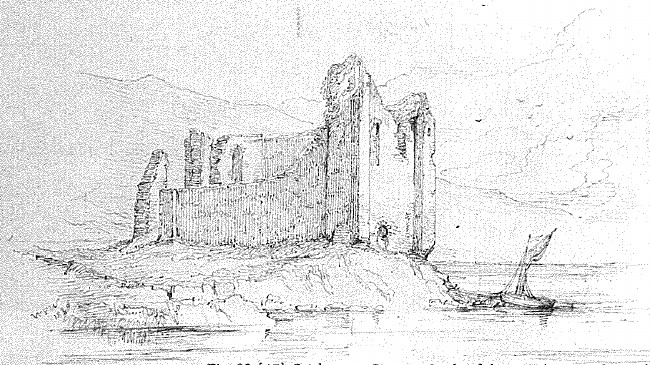
[Hand of W. F. Wakeman:]
This Castle cannot be easily measured on the outside in consequence of the manner in which it overhangs the rock. Il measures on the inside 42feet. in length and 29feet. in breadth. In the South wall is a small room arched over head called O'Connor's room probably from the original founder. It measures 9½ feet in length, 5feet 9inch, in breadth and 6feet. 3inch, in height.
[Hand of John O'Donovan resumed:]
To this part of the parish of Cong also belongs the Island of Incha Goill, situated in Lough Corrib about midway between Lemonfield and Cong. It is described by O'Flaherty thus in his account of the Seigniory of his ancestors:
Inis an Ghoill, so called of (i.e. from) a certain holy person who there lived of old, known only by the name of "an Gall Craibhtheach", i.e. the devout foreigner, for Gall {in (i.e. one of) the Gallic nation†} they call every foreigner; so Inis an Ghoill is the foreigner's Island, between Ross and Moycullen barony on Lough Orbsen, contains half a quarter of pleasant land belonging to Cong Abbey, and hath a fine chapple therein, which is not for the burial of any body. On the island died Anno 1128 Murgess O'Nioc, Archbishop of Tuam.
Inis an Ghoill hath two chappells, the one dedicated to Saint Patrick, the other to the saint of whom the island is named, which admits not the burial of any body, but in the first it is usual to bury.
p. 20
†The text of O'Flaherty is here corrupted by the transcriber; It should run thus: "Inis an Ghoill, so called of a certain holy person who there lived of old, known only by the name of an Gall Craibhtheach, i.e. the devout foreigner, for Gall {which originally meant one of the Gallic nation} they call any foreigner" &c. In like manner a Frank means foreigner in the East.
Of these (two) chapels, the one dedicated to St. Patrick is by far the older. It is, like all the primitive Irish churches, divided into nave and choir, and its doorway, which is placed in the west gable, is in the Semi-Cyclopean style. The nave is 23 feet long and 17 broad, and the choir is 11ft. 6in. long. The doorway is at present 5f. 9in. high, lft. 9½in. wide at the top, and 2ft. 1in. at the bottom. The lintel is 4f. 8inch. long 1ft. 0in. high and originally extended the entire thickness of the wall, that is 2f. 7in., but it is now (partly) broken on the inside. This doorway is constructed thus: [Fig. 94]
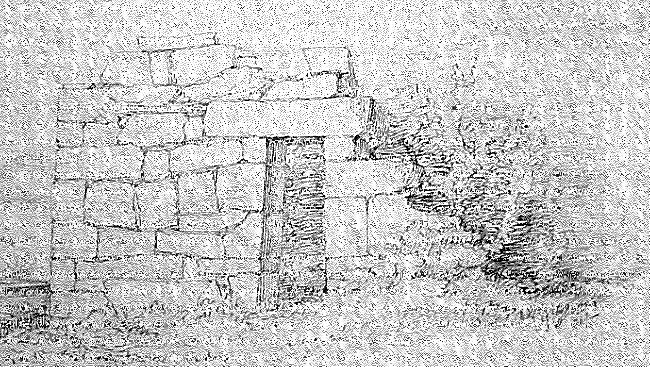
The other chapel, which (as) O'Flaherty says, was dedicated to the Gall Craibhtheach is now called Teampull na naomh, i.e. the church of the Saints. It lies a short distance to the South east of the church of St. Patrick, and a (winding) old road or passage which led from the one to the other is still distinctly visible (traceable). This church was a highly finished specimen of the kind of religious houses erected by the Irish from the 8th to the 11th century, but the antiquary has to lament that it has suffered severely from the tooth of envious time. Enough of it however remains to satisfy the curious investigator of the architecture of the ancient Irish that it was a highly finished little church, and as the strength of a lion may be inferred from one talon, and one jaw, so may the beauty of this Church be proved from the fragments which remain of its characteristics.
Like Patrick's church it consists of a nave and choir (but it is built of smaller stones). The nave measures on the inside 21f. 10in. and in breadth 12f. 9in. The choir measures on the outside 11f. 6in. in length. The choir arch is still standing but has suffered so much from the storms and particularly from that of last January, that it must soon give way. It is about 8f. 8in. high and 8f. 8in. broad.
The south side wall contains a window, which is broad inside and narrow outside, being on the inside 1ft. 7½in. wide (near the top and 2ft. 0in. at bottom) and 3ft. 9in. high. There is a very ancient stone inserted in this wall, ornamented with a cross, but no inscription. The west (gable) contains the doorway, which was highly finished (very like that in the church of Killeshin near Carlow), but now very much injured. It consisted of three concentric arches formed of red grit (greet) stone but the two external ones are now (nearly) destroyed. The arch which remains, which is properly speaking the doorway, is 5f. 9in. in height, 1f. 11in. broad at the top, and 2f. 5in. at the bottom. The walls of the church are 2f. 3in. in thickness, and the inner arch is 1ft. 4in. in thickness.
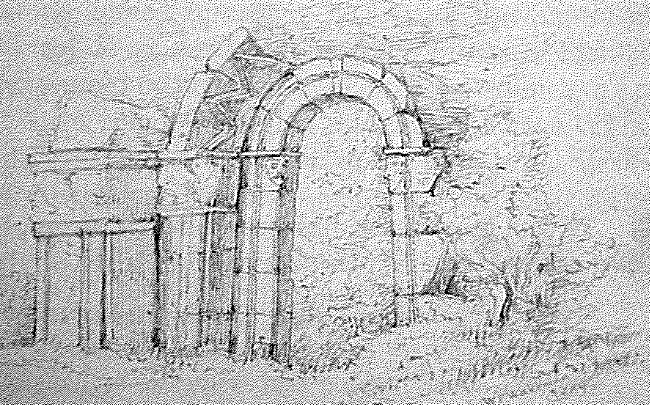
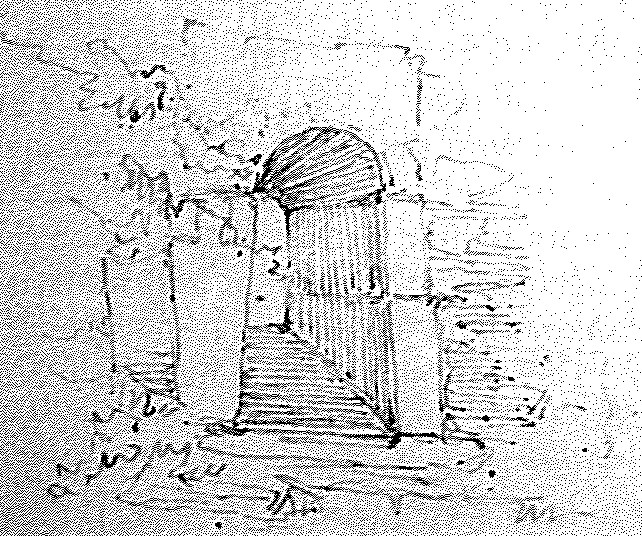
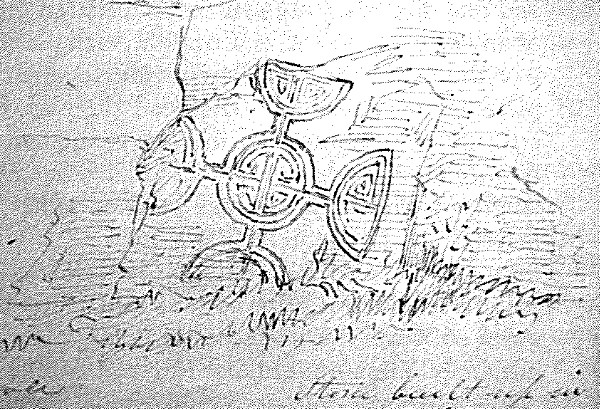
At the North-east corner of the choir there is a square tomb which is probably that of the archbishop Muirges O'Nioc, who died on this island in the year 1128.
A short distance to the South west of this church is a small head stone (of hard granite) now 3f. 0in. over ground, and not more than 5 inches square, which exhibits a very ancient inscription in the Roman characters of the 5th or very beginning of the 6th century. This stone has two crosses on each side of it, but on the reverse side to the letters one is nearly broken off. The following is a facsimile of the inscription.
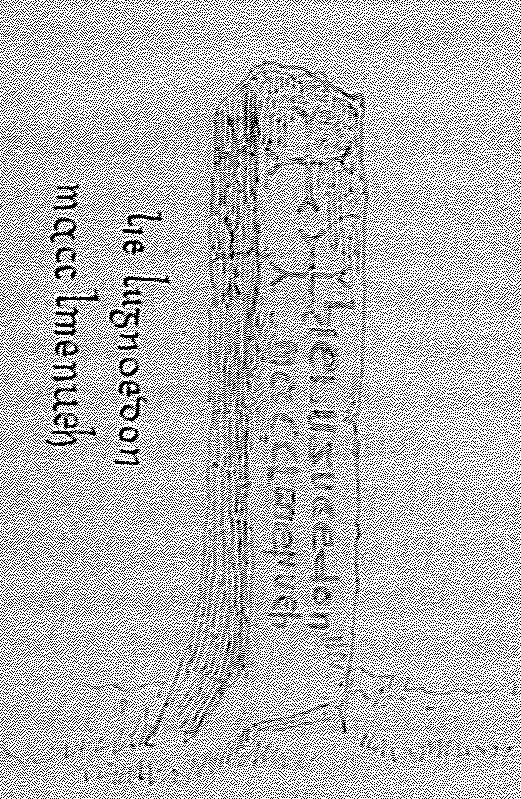
That the authenticity of this inscription may be tested at once an alphabet of the 7th century (as many of the letters as occur in it are) here given as published by Astle from a MS. in the Cottonian Library.

As this inscription has been already attempted to be decyphered by a Tipperary man, I shall here transcribe what Mr. Dutton has published on that subject in his Statistical account of this County.
About the centre of Lough Corrib is an island called Innishgoile, about a mile in circumference, and thickly inhabited. In the middle of this isle there is a very ancient churchyard and the ruins of an old dwelling house, which oral tradition, and many corroborating circumstances represent as the retired abodes of the heads of some monastic order in ages past. The island contains also an old chapel, dedicated to the memory of St. Patrick. The different arches and entrances (there are only two doorways altogether; the one in the semi-cyclopean, the other in the round style) into these buildings were of the common Saxon order, and the stones of which they are composed are carved into human features, and one of a red gritty substance although there does not appear in the neighbourhood a single vestige of any quarries of that description. Such parts of these decayed edifices as now remain are supported by woodbine and ivy, which entwine together, and forming a complete roof present an uncommon picturesque appearance. The head stone of a grave in the South west part of the island, having lately attracted the attention of a military gentleman of much information and research quartered near the spot, he was induced to shew it to an intelligent soldier of the Tipperary militia, well acquainted with the Irish language. The soldier whose name is James O'Farrel, has ingeniously decyphered and translated the inscription
upon it. It is written he says, in the hard Irish, or virgin (this is an attempt by the soldier at saying vigular characters. What characters we have had in this island of Saints!) characters {the Ogham} and is in English: "Underneath this stone lye Goill, Ardan and Sionan". These are supposed to have been brothers, and the island, it is believed, was called after Goill, the eldest of them, who was the chief in the religious order on it and esteemed for exemplary piety and devotion. There is no mention made of Innishgoile in Sir James Ware's Antiquities of Ireland, nor do we remember to have seen any notice of it by Dr. Ledwich, or any other writer upon the subject, although many extraordinary (traditions) respecting this island are affloat, the truth of which is, in many instances, strengthened by strong corroborative testimonies; amongst others, the following is rather singular {if true}. The noise of beasts and birds upon the island is said to have been so loud and so often repeated as frequently to have interrupted the devotional exercises; in consequence of which an earnest appeal was made to heaven, and although the place still contains many of the quadruped and winged species, the former is not heard to bellow, or the latter to warble, &c. The above was extracted from a Galway Newspaper.
pp. 473, 474.
That this decyphering of the head stone on Incha Goill is (however) a humbug will be clear to the learned world, as soon as a fac simile of the inscription shall (will?) be published. At present the Irish literati neither know nor care any thing about such things. That this Lugnoedon Macc Imenueh (Lugnoedon Macc Imenueh), was no other than Praesbyter Lugnath, (who was) the son of Liemania, otherwise Darerca, the sister of St. Patrick, is highly probable, tho' we have no account of his having lived on (or being being buried on) this island.
According to the Book of Lecan, fol. 51, p. b, col. 5, Praesbyter Lugna {otherwise called Lugnath} was the alumnus of St. Patrick and the son of his sister, and he was located at a place called Fearta, in Tir Fheg on Lough Mask, where Duach Teanga Umha, king of Connaught, gave him and his fellow labourers the lands extending from that part of Lough Mask called Snámh Tir Feig to Sail Dea. In the same MS, fol. 45a, 1, he is called St. Patrick's Luamaire or Navigator.
The Irish authorities are not (however) at all agreed upon the history of this saint, some making him the son of St. Patrick's sister Lupita, some of his sister Darerca, and others of Liemania! But this stone is a cotemporaneous monument, and should be received as historical evidence to prove that he was the son of Liemania. This inscription is the oldest Christian monument I have yet seen, and whatever doubts there may be about the history of this saint as given in the Irish MSS. there can be none about the authenticity of this inscription. I here insert all the notices (of Lugnath) hitherto discovered.
[Hand of Patrick O'Keeffe:]
DE S. LUGNA SEU LUGNATHO
Quinta Appendix ad Acta S. Patricii, Caput IV.
{De Sancti Patricii fratre, sororibus, earumque Sanctis liberis}
{Tr. Th. p. 226, b} n. 6. De filiis verò Liemaniae sororis S. Patricii major est authoruin discrepantia, & hinc ambigendi ratio; cum quos nonnulli ei attribuunt filios, alii Darercae filios appellent. Liemaniae duos filios ex Restituto Huabaird, sive, {quod idem est} Longobardo genere susceptos, nempe S. Secundinum, & S. Nectanum diversa tribuunt Martyrologia mox citanda; & cum in aliis vetustis monumentis legamus eundem Restitutem ex sorore (a sister) S. Patricii suscepisse septem alios filios, omnes Divis connumeratos; consequeus erit Liemaniae novem filios extitisse sanctos. De Secundino ita scribit Calendarium Casselense ad 27 Novemb. ***
{p. 227, a}. Nec solum duos jam memoratos, sed & quinque alios filios Liemaniae extitisse, eorumque
omnium patrem fuissè Restitutum Longobardum tradit Martyrologium Tamlactense, vel veriûs ejus vetustus Scholiastes ad 18 Martii veteri & rudi stylo dicens: Decimo quarto Calendas Aprilis, Auxilinus Episcopus, & frater, id est, cognatus S. Patricii Episcopi, vel Auxilius nomen ejus Patricius dixit: Auxilinus tuum nomen apud nos: ordinatus es meus Comorbanus; es amice filius meae sororis, & Episcopus, & spiritualis pater. Septem filii Restituto de Longobardis, Secundinus, Nectanus, Dabonna, Mogornanus, Dariocus, Auxilinus, & Lugnath. Ex his habemus Liemaniam septem filios habuisse Restituto Hubaird, sive Longobardo, genitos; nisi velis {quod absit} duas S. Patricii sorores eidem Restituto nupsisse, & utramque, non solum diversos, sed & eosdem filios, nempe Secundinum & Nectanum, ex eo suscepisse &c &c. ***
{p. 228, a} n. g. Septem sane filios Restituti Longobardi, quos suprà citati authores ex Liemaniae Patricii sorore suscepisse memorant, Darerca matre genitos fuisse, tria vel quatuor subindicare videntur fundamenta, ac proinde Darercam & Liemaniam
duo esse ejusdem sororis Patricii nomina diversa. Primun ergò est, quod S. Secundinus, qui à diversis Authoribus suprà citatis, vocatur filius Liemaniae, ab aliis vocetur filius Darercae, & Restituti. ***
Secundum, quia Darercham fuisse uxorem Restituti Hua-baird, sive Longobardi, filiorumque ejus matrem, tradit S. Evinus in vità Tripartita S. Patricii, part 2. c. 21. ***
Cui {S. Evino} & conseutit Usserus, qui {quod quartum pro hac re argumentum est} de Primordiis Ecclesiarum Britannic, pag. 824, ubi ex quodam veteri Anonymo asserit Darercae secundum maritum {primus enim erat Conis} fuisse Restitutum genere Longobardum, ex quo suscepisse indicat septem filios supra memoratos inter Liemaniae filios. Restituti, inquit, alterius Darercae mariti, septem in Sanctorum Hiberniae Genealogiis numerantur filii; Sechnall {id est Secundinus} Episcopus,
Nectain Episcopus, Dabonna Sanctus, Mogornan Sanctus, Darioc Episcopus, Auxilius Episcopus, & Lugnath Sanctus.
p. 228 n. 10. {abstract} {None of the martyrologies mentions the festival or memory of Liemania under this name; but they have that of S. Darerca on the 22nd of March. Colgan considers Darerca as an Epithet (or cognomentum) rather than name. Dair-shearc, i.e. firmus vel constans amor, or Der-shearc, i.e. lachrymarum amor.}
Ead.: Appendix, idem caput, Tr. Th. p. 229, b, Nu. 13. *** Haec de fratri & sororibus; sequentia de S. Patricii nepotibus accipe, juxtà ordinem, qui supra recensiti sunt.
p. 231, a, Nu. 14. S. Lugnatus Praesbyter; cognomento sanctus, septimus Restituti ex Darercae filius. Juxta authores supra citatos, videtur esse qui sub nomine S. Lugnae, vel Lugnéi Praesbyteri die 20 Jan. colitur in Ecclesia de Kill-tarsna; vel alter homonymus, qui in Ecclesia Letterensi colitur 25 April, juxtà Mart. Jaml. Martyrol. Dungallense & Mar Gorm.
Book of Lecain fol. 51, page b, col. 5.
Cruimthaig Lugna dalta Padraicc & mac Seathar in .vii. mug ([Inserted in pencil:] seachtmhadh) mac Ribaird ic nat feartaibh ic tir fheag for loch mesca isand ronalt sancht Briget .i. Feac mac Deaeig & Dordan & Mechar mac Odrain.
Do rad Duach tenga umae mac Feargusa, mac Muireadaig Mail mac Eogain sreim mac Duach Galach mac Briain mac Echaig mac Forba doib otha snam thiri feig co sail. dea.
This is the only mention I can find of Lugna or Lugnathan in the Book of Lecain. Mac Firbis gives the same account of this Lugna. The Irish Calendar has the following notices, Lughna sagart ó Cill Tharsna January 20, Lughna letrach 25th April, Deacan (N. Lughna Deacon aon dona hocht Macuibh Maonach mac Cairill do fliocht Luightha mac Ithe. Irish Calendar 31. Decr.) 31st December, sagart 21st. July. The name does not occur in the Féilire Aenguis at any of the above days. I can get no account of Inis Goile or the Gall-Craibhdeach.
Eugene Curry
[Hand of J. O'Donovan resumed:]
ORIGIN OF THE JOYCES
Mr. Martin of Ross urged with me that the Joyces had not a single acre of land in the Barony of Ross until they settled there as farmers under the Provost of Trinity College; but he was far from convincing me, because I am sure he knows nothing at all about their history, and I have authority to prove that the (now) barony of Ross was called Duthaidh Seóigheach before Trinity College was in existence. See Annals of the Four Masters at the year 15 ?
Mac Firbis and O'Flaherty agree that the family of Joyce are of Welsh origin, and this perfectly agrees with the tradition now current among themselves and their neighbours. To this tradition Mac Sweeny alludes as follows in his song about the wandering goblin called the Puca.
Go bh-feachfaidh sé fós é le cumas a chnámh,
Do chinéal na n-gaisgidheach 's na ridirídhe cródha
Do ghluais le Strongbow chugainn ó Bhreatain anall:-
le com an tráthnóna, no tamall roimh lá
Bheidheadh (sé) d'á lasgadh le bata 's le dórnaibh
Go g-cuirfeadh sé móid air gan filleadh go bráth!
I have good hopes in the action of Patrick Joyce
That he will yet try him with the strength of his bones,
That came to us with Strongbow across from Britain
In the evening twilight, or a short time before day
He would thrash him with a stick or his fists
Until he would make him vow that he would never return.
Duald Mac Firbis thus traces the pedigree of Joyce of Teernakill in the Parish of Ross in 1645.
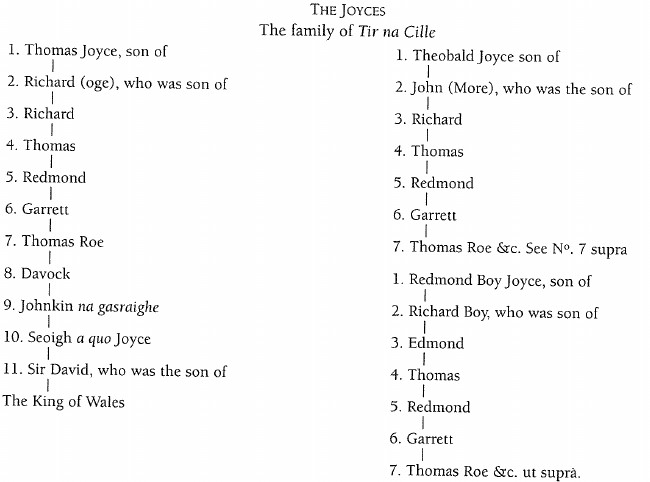
N.B. The Seoigh from whom the Joyces of West Connaught are descended, was the son of Sir David, who was the son of the king of Wales.
THE SLIOCHT RICKARD JOYCE AND SLIOCHT DAVID AND OTHERS
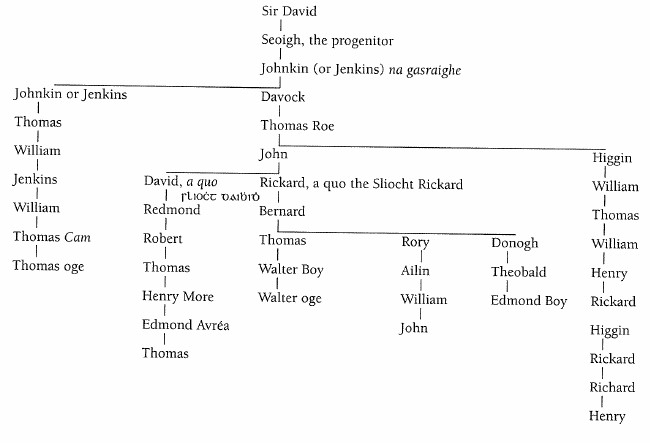
Supposing that Sir David came with Strongbow about the year 1172. Henry Joyce, the 14th in descent from him must have flourished about the year 1592.
14 generations 1172 30 years to each 420 420 1592
Are the Joyces mentioned in the list of the Anglo-Norman and Welsh families who came to Ireland with Strongbow, given by Hollingshed?
John O'Donovan.

